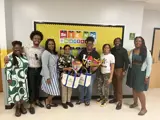Edelman Fellowship: Teachers use learning experience to craft engineering lessons for students

By Titoya Murphy, Northwestern Legends Elementary School
Titoya Murphy was part of a team of teachers from Northwestern Legends Academy who used the Edelman Excellence in Teaching Fellowship to travel to Boston, Mass., to attend the Engineering is Elementary (EIE) professional development program at the Museum of Science. The team's goal was to acquire new engineering modules and insights that they would share with colleagues through direct implementation in their classrooms and collaborative discussions. For more information on the Edelman Excellence in Teaching Fellowship, visit edelmanfellowship.org.
First, I would like to sincerely thank Mrs. Edelman for this incredible opportunity. We had the privilege of visiting the Museum of Science in Boston, Massachusetts, where we participated in a highly engaging and informative three-day teacher training. This professional development workshop was specifically designed to equip coaches, facilitators, and administrators with the skills and knowledge necessary to champion the EiE (Engineering is Elementary) curriculum effectively in their schools.
The workshop provided an in-depth introduction to the EiE framework, emphasizing the importance of integrating engineering concepts with real-world applications to enhance student learning. The sessions were interactive and hands-on, allowing us to immerse ourselves in the same learning experiences that students would encounter. We engaged in a series of carefully crafted activities that highlighted the engineering design process while fostering problem-solving, critical thinking, and collaboration.
The hands-on activities included:
- Creating Safety Vests: We explored the importance of designing safety gear to protect workers in hazardous environments. Through this activity, we analyzed materials and their properties to construct a functional and effective safety vest.
- Building Night Lights: This activity introduced basic circuitry concepts, where we designed and assembled a night light that met specific design criteria. It was an excellent example of integrating science and engineering to solve a real-world problem.
- Constructing Rescue Shuttles: We applied the principles of force, motion, and energy to create rescue shuttles capable of safely transporting passengers. This task required thoughtful planning, testing, and iteration to optimize the design.
Each activity was accompanied by an engaging story that contextualized the engineering challenge, making it relevant and relatable to students. These stories provided a narrative that not only captured student interest but also encouraged them to think critically about real-world challenges and possible solutions.
The next step will be implementing the EiE curriculum with our students, allowing them to engage in these hands-on, inquiry-based projects. By guiding them through the engineering design process, we aim to cultivate curiosity, creativity, and confidence in their ability to solve complex problems. I am excited to bring this enriching experience to my students and witness how the EiE curriculum inspires them to think like engineers.
Once again, I am truly grateful to Mrs. Elderman for this extraordinary opportunity, which has not only enhanced my instructional practice but also empowered me to foster a deeper understanding of engineering principles among my students.
My sincere thanks,
Mrs. Murphy
